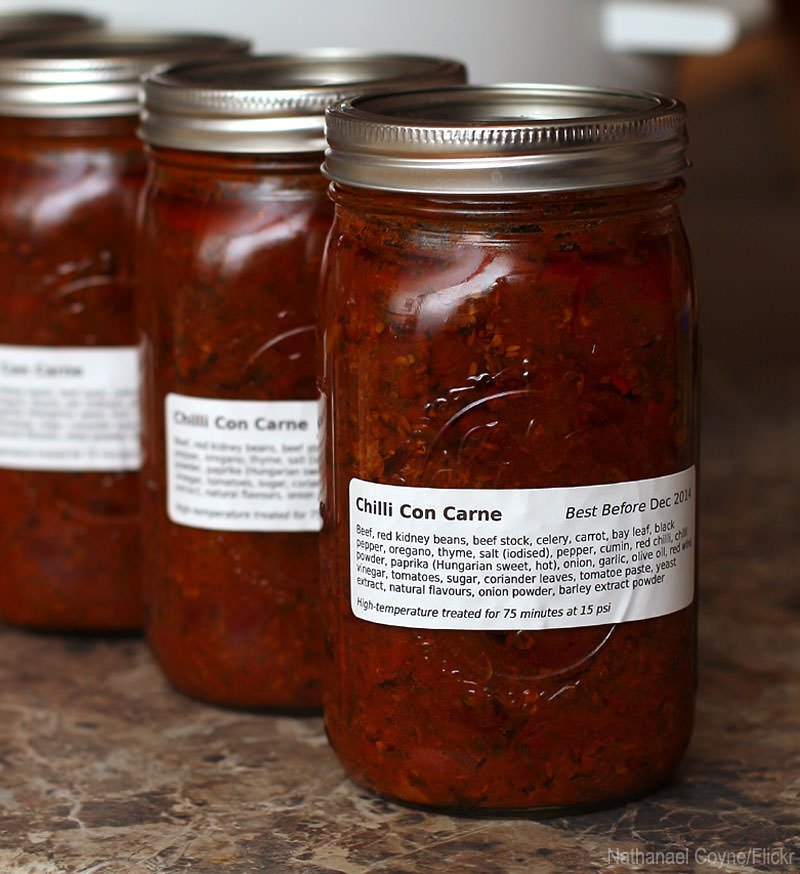
 Photo by Nathanael Coyne/Flickr |
Pressure canning meat opens up a world of possibilities. Home-canned chicken soup is medicine in a jar for winter colds. Waste nothing by canning bone broth from carcasses. And if you’re lucky enough to live near an ocean, home-preserved tuna and salmon is something truly better than anything you can buy in the store.
Dust off your canner and fill your pantry with preserved meat with these nine tips from experienced home canners.
1. Practice Safety First
Meat must be canned using a pressure canner, not a water bath canner. You’ll need a calibrated dial or weighted gauge canner, new lids for your jars, and a trusted, timed recipe. “When it comes to safety, I rely on the National Center for Home Food Preservation,” says Joel MacCharles, author of the blog WellPreserved.ca. “Their website isn’t the prettiest, but you can easily find everything you need to can safely, including standards for the amount of pressure and time needed for different things.”
2. Have No Fear
The pressure-canning process is intimidating to many people because pressure canners steam and hiss; however, it’s much simpler than you might imagine. “My biggest hurdle was the idea of the meat canning process,” says Denise Beno, former operator of 2Silos organic poultry farm. “But if you have a bit of common sense, it’s really easy and a great way to store ‘ready-to-serve’ meats.”
3. Think Big
Pressure canning meat takes a long time on the stove, so you’ll want to maximize energy usage by canning large batches. “If you’re looking to buy a pressure canner, buy the biggest one you can get your hands on,” MacCharles says. “It’s a great container for storing canning supplies and it will allow you to preserve more at once.”
4. Preserve Systematically
Small families might not eat enough meat to justify a lot of pressure canning. That’s when the freezer comes in handy. “When we make a chicken dinner we freeze the carcass,” MacCharles says. “The next time we have a chicken dinner we make a 2-carcass stock. It makes about 5 quarts of stock and fills our house with the most wonderful smell.”
5. Use Dried Herbs
“I don’t recommend using green herbs in your canned meats, for appearance’s sake,” Beno says. Fresh herbs will often turn brown in the canning process and tint the meat green. While there’s nothing wrong with the flavor or safety of meat made with fresh herbs, most people instinctively find green-tinged meat unappealing, so dried herbs are recommended.
6. Preserve What You Want to Eat
As is true of any canning, think about what your family typically consumes before firing up the canner. There’s no sense in making a big batch of canned beef tips if you don’t cook with them. “I sometimes pressure can soup and beans when I have some free time, usually when watching sports on television,” MacCharles says. “I preserve intensely flavored soup that I add milk, stock or water to when I need a meal in minutes.”
7. Match the Jar to the Meat
Think about the quantity of soup or stock your family usually consumes and choose your jar size accordingly. “If you want to can bologna or loaf-style meats, use wide mouth pint or 1½ pint jars,” Beno suggests. “This makes it easy to slide out the meat loaf for slicing.”
8. Leave Rings On
Most canning teachers recommend storing jams, jellies and pickles without the rings so that the rings won’t rust in place or accommodate insect nests. Meat can be a little different. Beno doesn’t remove the rings from her canned meats because mice can chew through otherwise.
9. Reheat Before You Eat
If you followed a pressure-canning recipe, processed the appropriate time and the jar sealed properly, your preserve is shelf-stable for a year, per USDA recommendations. Observe your jar before using for an unusual signs and discard if you notice anything out of the ordinary. Reheat stock and soup by boiling for 10 minutes, to 140 degrees F, before eating as an added safety precaution.
Pressure canning meat is often considered an advanced canning skill, but the rewards are too good not to accept the challenge. Heed the experts’ advice above and you’ll build a pantry full of nutritious, tasty home-cooked meals in a jar.
Get more canning advice from HobbyFarms.com:
- 9 Fixes for Canning Problems
- 8 Natural and Healthy Canning Substitutions
- 10 Must-Have Items for the Canner’s Pantry
- 6 Things Not to Do While Pressure Canning
- 10 Tips for Starting a Canned-Food Business




